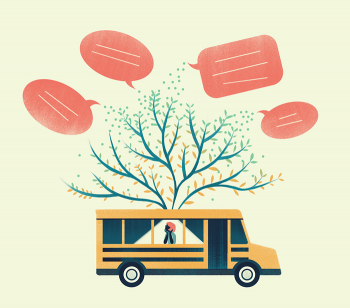This is an adapted excerpt from the introduction to Schooltalk: Rethinking What We Say About—and to—Students Every Day published by The New Press.
[E]verybody talks.
And because communication is action: talk about (and with) young people shapes their lives.
Schools are where we shape the next generation and through them, the world.
And the most basic thing we do all day in schools is talk.
Equity work—active effort to develop the full human talents of every young person, and all groups of young people—starts with our words.
We talk about a million things in schools as we educate young people. We talk about math and science and literature and social studies; we discuss the nation and the world.
In this book, we’re redesigning the most foundational form of schooltalk: talk about young people themselves. That’s because such schooltalk causes some of our most fundamental problems for young people.
All school pathways for students are shaped by basic communications about students.
Sometimes, single communications change our paths.
I always loved to write. I remember one librarian telling me that a little book I wrote in kindergarten was so good she was going to put a copy in the library. (Then she actually did it.) She was the first person to call me an “author.” And I remember my dad telling me that one day maybe I’d become a “writer.” His expressed confidence in me shaped my identity—as did the opportunities teachers then gave me to develop my writing skills.
I also remember that once in grad school, a professor told me that I “probably shouldn’t become a writer.” I still hear his voice in my head along with the others’, making me doubt my abilities.
I know countless people who remember comments in school classrooms or offices that either fostered or threatened their own potential. For example, a high school counselor told my colleague Daniela* that as a Latina, she just shouldn’t try to make it to a top university. Daniela remembered that uninformed comment for the rest of her life. The same type of comment from counselors deflated many of her Latino peers—who didn’t hear much from counselors about how to get to college, either.
Daniela actually defied that counselor’s prediction and went to Berkeley, then Stanford, to become a professor of education who studies how to support Latino students through college. After Daniela got her PhD, she went back to that counselor to make sure he never talked down the potential of another young person.
Whenever I tell that story, listeners have something similar to share.
Millions of common things we say about and then to young people can shape students’ fates in schools. Consider each of these examples:
- A teacher or peer calls a student’s community “ghetto.” How might this shape young people’s sense of themselves, their classmates, and their school?
- A counselor calls the student body “not college material” in a faculty meeting about whether to offer more AP sections. How might the comment affect the group’s thinking?
- A teacher’s aide or specialist describes students in the car ride to school with words like “Special Ed kids” or “losers,” or, conversely, describes a few students as unusually “gifted” or “smart.” How might he or she treat each of these students in class?
- Administrators explain a chart of achievement outcomes, broken down by race, language group, gender, or disability, in a faculty meeting as they make decisions about hiring additional support staff. What happens to the analysis of student needs when someone says summarily that one group of kids “just doesn’t want to learn”?
- In a college or graduate school classroom, future teachers try to discuss why some students drop out of school and end up in prison. What happens to planning for student support when someone says that it must be because these students’ parents “don’t care about education” enough?
Each communication is an action with serious equity implications. As we’ll see throughout this book, the thingspeople say about students in schools shape how adults think about and treat students, how students feel about themselves and their peers, and who offers students which opportunities and assistance. Words lead to treatment and to self-concepts, to expectations internalized by adults and students, and to the distribution of material resources by adults. Who gets which dollars, teachers, daily supports, and opportunities to learn—schooltalk is involved in all of this. Schooltalk about history, current events, and policy similarly shapes how opportunities get to young people, by shaping who we think “deserves” opportunities and who we hold responsible for providing which opportunities to whom. Even schooltalk far away from schools matters. Think of the consequences if a politician talking about schools in “the inner city” frames young people as totally uninterested in reading, then floats a school funding bill.
Schooltalking isn’t the only action we can shape for equity in education. It’s just a foundation of equity work—where it begins. And it’s a realm of equity action available all day, every day. Redesigning schooltalk just requires reshaping what we already do.
As an educator friend of mine put it after reading this introduction, “How I talk about students and the messages I convey to them or to others will influence the decisions we make about how we instruct and support students.”
What folks say about young people has consequences for them. But schooltalk has another common problem: what we fail to say.
In and around schools, we routinely fail to share necessary and accurate information about who young people are, what they can do, what they need, and how they are doing. These failures to communicate have consequences for students too; they regularly keep adults from understanding young people and offering them sufficient supports.
As a new teacher I had a tenth-grade student, Jake, who had trouble reading aloud and acted silly a lot. I learned late in the year that he got special supports in another class for a learning need nobody had ever talked to me about. I knew from a teaching partner that Jake’s mom worked late and that he stayed up anxiously waiting for her, but Jake and I never talked about this and I never met his mom. Jake made me laugh and drove me crazy. I never really got to know him, and I didn’t support him successfully as a reader, either.
And one day two years later, Jake almost didn’t graduate because school staff had told him inaccurate information about the credits he needed for graduation. I found him sitting dejected on the school steps on graduation morning. He had just heard he wasn’t graduating after all. We went to the office and had an accurate discussion of his credits with school administrators, clarifying that he had completed every credit adults had told him he needed. The counselors adjusted his transcript. Jake graduated.
Those eleventh-hour communications changed Jake’s life. I’m glad I was there that day.
But I could have helped Jake far more if I and others had talked earlier about specific things he was experiencing and specific ways of supporting him in school.
Just like the things we say about young people in schools, the schooltalk we don’t hear is predictable and patterned too. In schools across the country, many educators know too little about students’ experiences, skills, and needs. Every year, many students vanish from the graduation stage without adults really knowing why.
In fact, school communities are full of structural cracks in communications—gaps in necessary schooltalk that keep many students from being better known and better served. ...
Across the country, educators don’t know important facts about young people’s neighborhoods or communities, know why specific students are absent, or discuss why they are suspended; adults don’t review key details about students’ progress or can’t find such information when they need it. Too few adults ask students what they experience inside or outside of school or what they can do; people fail to discuss crucial opportunity information with each other or with parents or students themselves. And so, we don’t figure out together how to get young people essential opportunities and supports.
You get the point—we can derail young people significantly when our schooltalk harms them, or when we fail to say things that can help them.
But when we take charge of schooltalk as a foundational action for equity, we can change the game.
This book seeks to support you to design new ways to talk about and with young people in schools, so that everything we say helps to develop the full human potential of all young people rather than limiting what young people can do.
Position yourself from here forward as an equity designer—as someone who asks, daily, which actions and situations need to be improved so all young people get the opportunities and supports they need and deserve.
*Names of individual students or educators in this book are pseudonyms for real people; they represent common schooltalk experiences. Names of researchers are real so that readers can find published resources.
Think/Discuss
Did anyone ever say anything about you in school that particularly supported your school success, or slowed you down? Try to remember one story.
Have you ever seen a young person harmed because people failed to share some piece of necessary information about him or her?
Have you ever insisted that others add a crucial piece of information to a discussion about a young person or group of young people you know? Have you ever hesitated to do so? Why, and what happened?
Does this communication help support equity (the full human talent development of every student, and all groups of students)? Or not?




0 COMMENTS